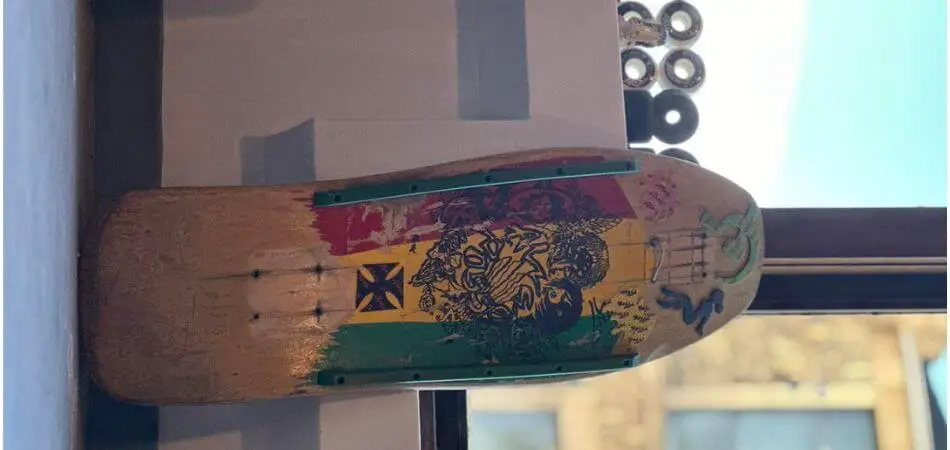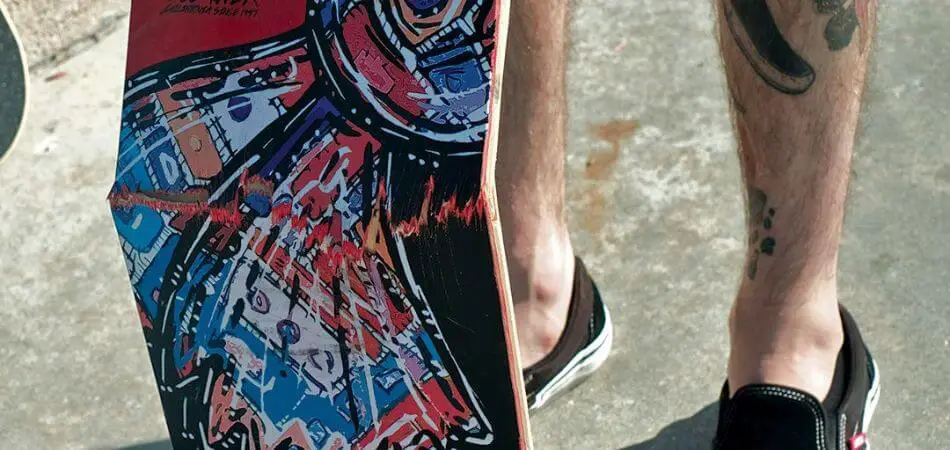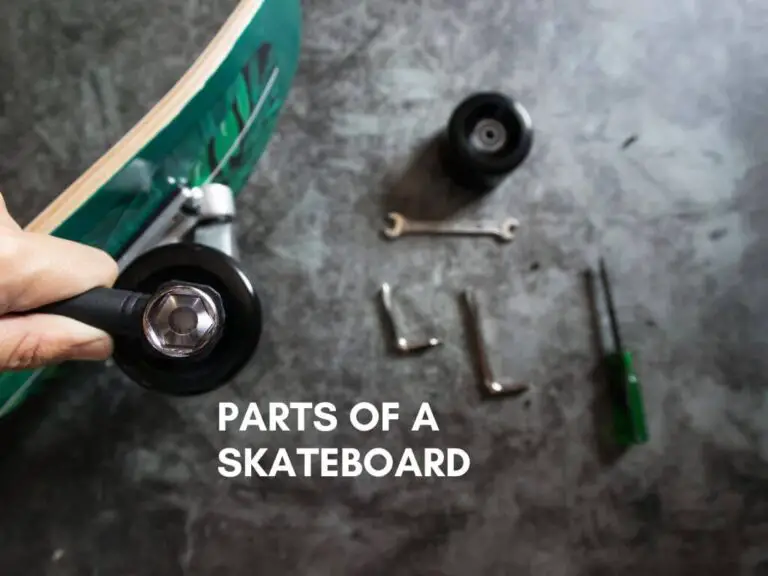To fix a cracked skateboard, apply wood glue into the crack and clamp the board until it dries. Sand the area smooth after the glue sets for a seamless finish.
Skateboarding is not just a sport, it’s a lifestyle. Every skateboarder knows the feeling of gliding on a smooth surface, the wind in their hair, and the adrenaline rush that comes with performing tricks. But what happens when your beloved skateboard gets cracked? Don’t worry! In this ultimate guide, I will show you how to fix a cracked skateboard like a pro, so you can get back to shredding the streets in no time.

Assessing The Damage
How to Fix a Cracked Skateboard? Before you can fix a cracked skateboard, it’s crucial to examine the extent of the damage. Proper assessment ensures a successful repair. Let’s determine if it’s a minor crack or if the board is beyond repair. A careful evaluation saves time and money and keeps you safe when you skate.
Identifying The Crack
Look closely at your skateboard. Hold it in good light and inspect every inch. You’re looking for lines or splits that indicate a crack.
- Surface cracks: May only affect the deck’s veneer.
- Deep cracks: Extend into the board and weaken its structure.
Marks and scratches are normal but do not confuse them with cracks. If you see a crack, mark it with a pencil so you won’t miss it later. Use a magnifying glass if necessary.
Assessing The Severity
A skateboard crack’s severity varies. Use the following criteria to assess:
| Severity Level | Description | Action Required |
| Minor | Surface cracks with no depth. | Possible to repair at home. |
| Moderate | Cracks penetrating deeper into the wood. | May need professional advice. |
| Severe | Deep, wide cracks compromising the board. | Replacement could be the safest option. |
Determining The Location
The crack’s location on your skateboard impacts the repair method. Is it near the trucks, or is it in the middle of the deck? Here’s a simple way to categorize:
- Near the nose or tail: These areas are prone to breaking.
- Along the sides: May affect the board’s flex and grip.
- In the middle: Can hinder the skateboard’s structural integrity.
Once identified, determine if you can reinforce the area or need to avoid certain tricks.
Preparing The Skateboard
Before fixing a cracked skateboard, it’s important to get it ready. Think of this process as surgery for your skateboard. It needs to be clean and free of any dirt for the best results. In this part, we focus on cleaning and preparing the board. Remember, a well-prepared skateboard ensures a smooth repair process. Let’s start with the basics – cleaning the cracked area and removing the grip tape. Follow these steps to prepare your board for fixing.

Cleaning The Cracked Area
A clean surface is key for a successful repair. Start by wiping down your skateboard. You can use a soft cloth and a gentle cleaner. Make sure the cracked area is completely free of dirt and dry. Here’s a simple bullet list to follow:
- Grab a soft cloth or brush.
- Use water and a mild cleaner.
- Gently scrub around the crack.
- Dry the area thoroughly.
Removing Grip Tape
Next, we need to take off the grip tape. This is the part that helps your feet stick to the board. However, it can get in the way of fixing the crack. Here’s a step-by-step guide to do it:
- Heat the edges of the grip tape with a hairdryer.
- Find an edge and start peeling slowly.
- Continue heating and peeling until all is removed.
- Go slow to avoid tearing the grip tape.
Tip: If the grip tape is stubborn, reheat and try again. Patience is important. You want a clean surface without tape residues.
Always double-check your skateboard for remaining dust or grip tape. A good surface will help the repair products to bond better. Keep the skateboard in a place where it won’t get dirty again.
Repairing The Crack
Repairing the Crack: Skateboarding is a fun activity until a cracked deck stops the show. But don’t let a split in your beloved board bench you. With the right tools and a bit of know-how, fixing a skateboard crack is doable. Here’s how to mend that beloved deck and get back to the skate park.
Choosing The Right Adhesive
Selecting a suitable adhesive is crucial for a lasting repair. A skate deck endures heavy impact and flexing. Use a strong, flexible glue. Epoxy or wood glue is best. Both bond well with wood and can withstand the rigors of skateboarding.
Consider these factors:
- Drying time should be quick to minimize downtime.
- Adhesive must be waterproof to protect against moisture.
- Flexibility is key to handle skateboarding stress.
Applying The Adhesive
Application matters as much as the glue choice. A clean, precise application ensures a high-quality repair. Follow these steps:
- Clean the crack: Remove all debris and dirt. This ensures a strong bond.
- Apply the glue: Fill the crack completely. Use a glue injector for precision.
- Clamp the board: Use clamps to hold the deck together. Apply even pressure across the crack.
- Wipe excess glue: Clean up any spillage with a damp cloth.
- Let it cure: Check adhesive instructions for cure times. Do not rush this step.
Once cured, remove clamps and test the board gently. If all is well, you’re ready to skate!
Reinforcing The Repair
Reinforcing the repair of a cracked skateboard is crucial for a sturdy and lasting fix. Proper reinforcement ensures the board can withstand the rough and tumble of skateboarding once again. The reinforcement process involves the application of specific materials that bond with the wood to create a stronger structure. Learn below how to reinforce a skateboard using fiberglass cloth and additional layers for a robust repair.

Using Fiberglass Cloth
To begin reinforcing your skateboard, fiberglass cloth is a fantastic choice. This material provides a durable layer that melds with the adhesive to create a solid repair. Here’s how to apply it:
- Cut a piece of fiberglass cloth to size, covering the crack and some surrounding area.
- Prepare a resin, according to the manufacturer’s instructions, to attach the cloth.
- Place the cloth over the crack and press it down gently as you apply the resin.
- Ensure the cloth fully adheres to the skateboard’s surface with no air bubbles.
- Leave it to cure as directed, usually for a few hours.
Applying Additional Layers If Necessary
Sometimes, one layer of fiberglass is not enough. Here’s what to do:
- Check the first layer for solidity after it cures.
- If the repair still feels weak, prepare to add another fiberglass layer.
- Repeat the application process for each additional layer.
- Let each layer cure fully before adding another to ensure the best bond.
- After the final layer, sand the area to create a smooth finish.
Note: Allowing each layer to cure fully is critical for a reliable repair.
Finishing Touches
Finishing Touches bring your skateboard back to its former glory. Attention to detail ensures a smooth ride. It’s not just about repairing the crack. The surface must feel seamless. Your grip tape needs to be just right. Follow these steps for a professional finish.
Sanding And Smoothing The Repaired Area
Once the glue dries, it’s time to sand. Use fine-grit sandpaper. Work gently over the repaired crack.
- Start with a 120-grit sandpaper.
- Smooth out any excess glue or uneven surfaces.
- Gradually move to higher grits, up to 220.
- The goal is a flat, smooth skateboard deck.
Check your work often. Feel the surface with your fingers. It must be smooth to the touch.
Reapplying Grip Tape
With a smooth deck, the next step is the grip tape. This ensures a secure footing. Proper application is crucial.
- Choose quality grip tape. It makes a difference.
- Peel the backing off and align carefully.
- Start from one end, smooth out any bubbles.
- Trim the edges with a sharp blade for a clean finish.
Done right, your skateboard will feel brand new. Enjoy your restored board!
Common mistakes to avoid when fixing a cracked skateboard
While fixing a cracked skateboard is a relatively straightforward process, there are some common mistakes that you should avoid:
- Rushing the repair process: Take your time and follow the steps carefully. Rushing can lead to a subpar repair job.
- Using the wrong type of epoxy resin: Make sure to choose an epoxy resin specifically designed for skateboard repairs. Using the wrong type can compromise the durability of your skateboard.
- Neglecting proper ventilation: Epoxy resin can emit fumes that can be harmful if inhaled. Always work in a well-ventilated area or wear a respirator mask.
Frequently Asked Questions Of How To Fix A Cracked Skateboard
Can You Fix A Chipped Skateboard?
Yes, you can fix a chipped skateboard. Apply wood filler or epoxy to the chip, sand it down, and reapply the skateboard’s grip tape.
To Do When Your Skateboard Breaks?
Stop riding immediately to avoid injury. Examine the damage to determine if the skateboard is repairable. Replace broken parts like trucks or wheels if possible. Consider buying a new board if the deck is cracked. Always ensure proper skateboard maintenance to prevent future breaks.
What To Do With Snapped Skateboards?
Repurpose snapped skateboards into art projects or furniture pieces. You can also recycle the wood and metal parts responsibly, or donate them to skateboards-for-art programs. Some skate shops offer recycling services or discounts on new purchases for broken boards.
How Do You Tell If A Skateboard Is Cracked?
nspect the skateboard deck for any visible splits or cracks. Pay attention to unusual flexing or creaking sounds when pressure is applied, which may indicate internal damage.
Can Skateboards Be Repaired If Cracked?
Yes, cracked skateboards can often be repaired using wood glue, clamps, and sometimes reinforcement pieces.
Conclusion
Wrapping up, repairing a cracked skateboard is manageable with the right tools and instructions. Ensure safety and extend your board’s life by addressing damages promptly. Embrace the DIY spirit—your skateboard and skills will thank you. Hit the pavement with confidence, knowing your board is as ready as you are.
Skate on!








